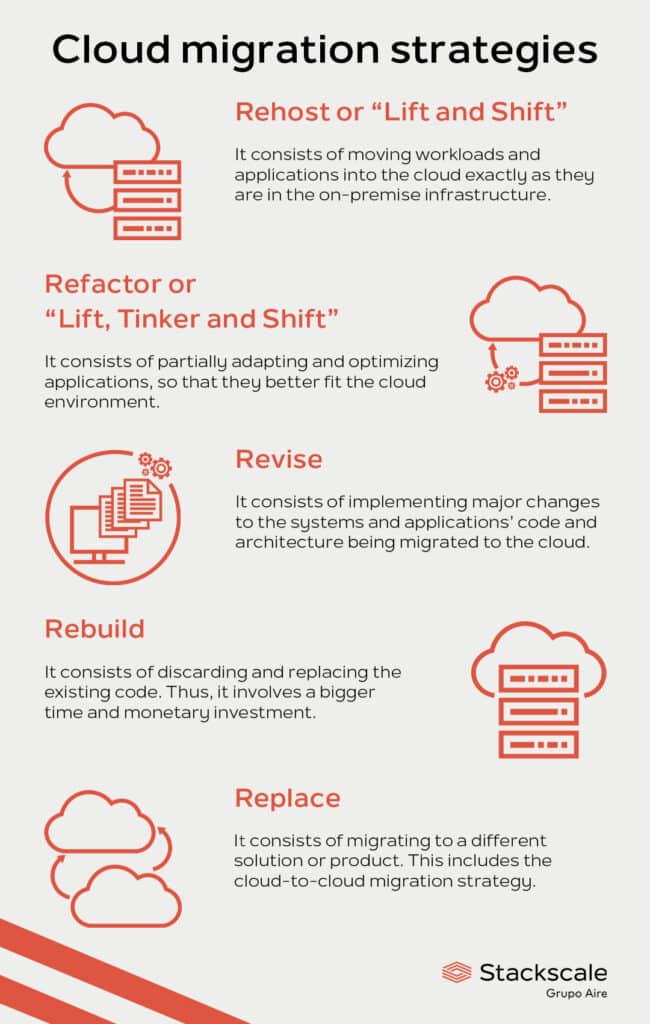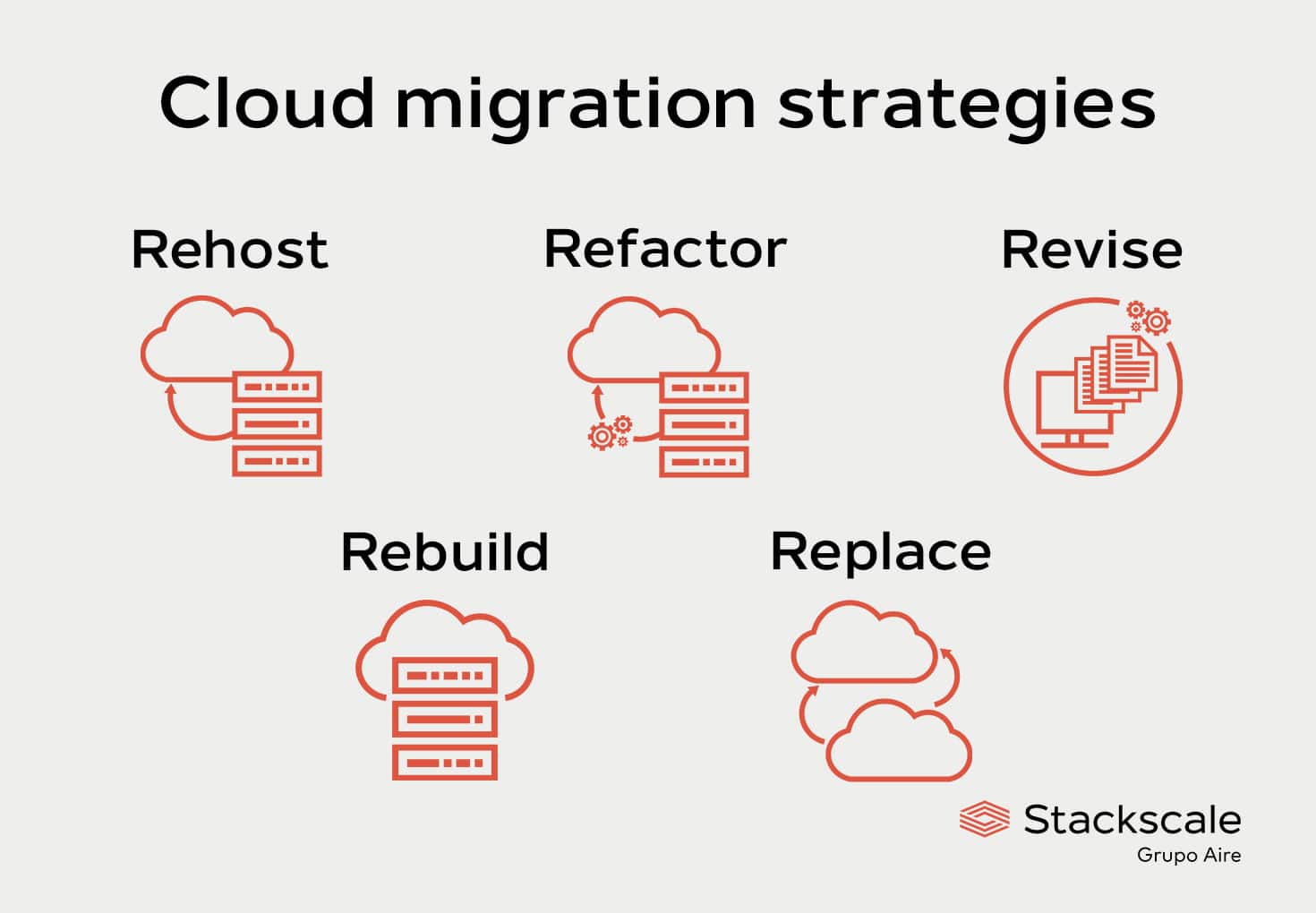There are different cloud migration strategies among which organizations can choose when they decide to outsource their infrastructure. As well as diverse challenges that they often have to overcome.
Main cloud migration strategies
A cloud migration strategy is a plan to move data, applications and workloads into the cloud. Cloud migration strategies generally refer to migrating applications, data and workloads from an on-premises infrastructure and architecture. Although the migration can also be done among different cloud solutions or types.
Each company has different reasons to migrate from on-premise to cloud or between different cloud solutions — cost optimization, security, performance, support, real data location, etc.
Let’s go through the main cloud migration strategies among which companies can choose:
- Rehost or “Lift and Shift”
- Refactor or “Lift, Tinker and Shift”
- Revise
- Rebuild
- Replace

Rehost or “Lift and Shift”
The rehosting or “Lift and Shift” migration strategy consists of moving workloads and applications into the cloud exactly as they are in the on-premise infrastructure.
In other words, companies basically “lift” applications from its in-house data center and “shift” them to a cloud environment, without significant changes. Rehosting is the most conservative cloud migration strategy.
It is also the fastest and least expensive strategy for moving applications to the cloud, since it can be done without implementing code changes. When choosing the rehost approach, companies often plan to optimize and re-architect whatever is necessary once the infrastructure is up and running in the cloud. This also allows the team to gradually improve their skills.
Lift and Shift is also the strategy with the quickest ROI (return on investment). Just by rehosting their workloads and applications companies can significantly reduce IT expenses. It allows to reduce the costs of running workloads and applications while increasing performance, security and scalability.
The rehosting strategy is also commonly used for migrating legacy systems or applications that organizations need or wish to keep using.
Refactor or “Lift, Tinker and Shift”
The refactoring migration strategy consists of partially adapting and optimizing applications, so that they better fit the cloud environment. However, it only involves a few cloud optimizations and adjustments, without modifying the core architecture. It is also known as “Lift, Tinker and Shift”.
This cloud migration approach is usually chosen to add certain features, performance or scalability, which it is not possible to get in the existing on-premise infrastructure. It allows leveraging further cloud capabilities.
Nevertheless, there is no one-size-fits-all approach. Depending on business objectives, some applications and workloads can be rehosted while others can be refactored.
Revise
The revising migration strategy consists of implementing major changes to the systems and applications’ code and architecture being migrated to the cloud. So that they can fully leverage the services available in the cloud.
Rebuild
The rebuilding migration strategy consists of discarding and replacing the existing code. As it involves a bigger time and monetary investment, this approach is only considered when an existing solution no longer meets the business needs.
Replace
The replacing migration strategy, also known as “repurchasing”, consists of migrating to a different solution or product. When choosing this approach, data is usually just migrated to a third-party application offered by a provider.
This includes the cloud-to-cloud migration strategy, which consists of moving applications and workloads from one cloud provider to another. Either because the company’s needs and goals have changed and another cloud provider is more suitable, or because it aims to change to a different type of cloud or cloud service model.
Challenges when migrating to the cloud
Here is a list of some of the most common challenges organizations face when planning a cloud migration:
- Lack of strategy. Taking into account the specific requirements of each application and workload is essential. Thus, it is important to define a clear strategy to ensure a successful migration to the cloud.
- Downtime or outage during the migration. On this matter, conducting migration tests is important to ensure that the final migration has no impact, or minimal impact possible, on the service.
- Data losses and security. To avoid breach risks and data losses during a cloud migration, it is important to implement security measures such as privileged access management and app encryption. As well as relying on the right Disaster Recovery plan.
- Resource management. Migrating to the cloud usually entails hiring new IT management roles.
- Cost management. From migration costs to future recurring expenses, considering all costs associated with a cloud migration is important to avoid surprises in the future. Additionally, keeping control of cloud costs is also essential.
- Interoperability. It is necessary to adapt processes so that applications can communicate properly within the new cloud environment.
- Skills. It is important to rely on a specialized team, either internally or externally, to ensure the migration is a success.
Cloud migration plan
Companies must carefully plan their migration to the cloud in order to make the most of it and ensure a secure migration. The migration process varies depending on the project. But a successful migration should include:
- Designing a cloud migration plan, that should start by assessing the current infrastructure and determining the requirements of the cloud infrastructure.
- Choosing a suitable cloud solution and service provider that fits your project’s needs and goals.
- Performing migration tests so that the final migration has no impact on the service, or the minimum impact possible.
- Testing and assessing that everything has gone as planned.
- Guaranteeing constant system management and monitoring to keep everything running smoothly, and proactively identify issues and threats.
The most suitable strategy will depend to a large extent on the size and complexity of the environment the company is planning to migrate.
Planning a migration to the cloud?
We can help you meet your company’s goals successfully. Contact us for further details about our cloud migration solutions.





